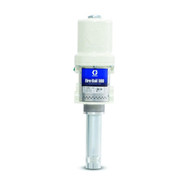What Piston Pump Ratio Do I Need for my Application?
Posted by Brad Schacht on Aug 3rd 2018
When pumping thicker, or more viscous, fluids such as lubrication oil, grease, or food pastes it is best to use the right pump for the job. For most, the right pump would be an Air Piston Pump, but many factors come into play when deciding which air piston pump to get. One of the most common questions we get asked is, “what does the pump ratio mean?” Here is a brief explanation to help decide which ratio is best for you.
What does a 1 to 1 ratio mean?
The pumping ratio, as explained by the Petroleum Equipment Institute (PEI), is the area of the air piston compared to the area of the fluid piston in an air-powered pump.
So when we have a 1:1 ratio, it means that the amount of air-input pressure is equal to that of the fluid-output pressure. For example, if the pump has 100 PSI of air going in then, there will be 100 PSI of pressure pushing the fluid out.
Similarly, if you have a 5:1 ratio pump with 100 PSI of air-input pressure. Then this will yield 500 PSI of pressure output.
It should be noted that when using the same air motor with different pumps the ratio will change. If the ratio goes up the flow will decrease. If the ratio goes down the flow will increase. For example, a pump and motor with a 5:1 ratio at maximum air pressure of 100 PSI will result in a maximum fluid pressure of 500 PSI and a flow volume of 15 GPM at 60 cycles per minute. Whereas the same motor and a smaller pump that has a 10:1 ratio, will produce a 1000 PSI maximum fluid pressure and a flow volume of 7.5 GPM at 60 cycles per minute at a maximum inlet air pressure of 100 PSI.
What ratio is best for me?
Determining the best ratio for your application requires some knowledge of what type of fluid is being pumped, how far it needs to flow, and how much air pressure is being provided.
ARO (Ingersoll Rand) provides an excellent online calculator for determining the best pump ratio for an application, but here are a few common examples on which ratios to use. All of these are assuming 100 PSI as a base air inlet pressure.
When pumping low viscosity fluids, such as cooking oils or motor oils, a 1:1 ratio air piston pump would be ideal for distances less than 100 ft. The relatively low resistance from these fluids requires less air pressure when pumping short distances.
Fluids with low to medium viscosity at a distance of about 150 ft. would best be pumped using a 3:1 air piston pump. This could be SAE 50 motor oils, syrups, honey, and some pastes.
When pumping heavier viscosity fluids or low and medium viscosity fluids a distance 200 ft. or more the 5:1 ratio air piston pump would result in the best pumping experience. Heavier viscosity fluids have a higher resistance to flow, which means more pressure is required. This could include fluids similar to mayonnaise or SAE 70 oils.
For even higher viscosity fluids, like grease, or for pumping farther distances there are greater ratios of pumps available here. For example, a popular ratio piston pump for auto shop grease is 50:1.
Please use this guide on pump ratios for common auto and truck lubrication fluids:
Fluid Pump Ratio
Engine Oil 1:1, 3:1, 5:1
Grease 50:1, 60:1, 75:1
Below is an NLGI Grease Chart which can assist in determining the thickness of a fluid. Many common oils and greases will have an NLGI number assigned to it. Typically, the higher the number, then the higher the pump ratio is needed. It all depends on the fluid thickness or viscosity, amount of air pressure, and pumping distance.
| NLGI number |
ASTM worked (60 strokes)
penetration at 25 °C tenths of a millimetre |
Appearance | Consistency food analog |
| 000 | 445-475 | fluid | cooking oil |
| 00 | 400-430 | semi-fluid | apple sauce |
| 0 | 355-385 | very soft | brown mustard |
| 1 | 310-340 | soft | tomato paste |
| 2 | 265-295 | "normal" grease | peanut butter |
| 3 | 220-250 | firm | vegetable shortening |
| 4 | 175-205 | very firm | frozen yogurt |
| 5 | 130-160 | hard | smooth pate |
| 6 | 85-115 | very hard | cheddar cheese |
https://en.wikipedia.org/wiki/NLGI_consistency_num...
Please contact us if you have questions regarding what piston pump ratio is best for your application. We are here to help!


